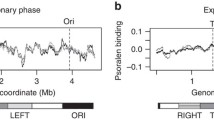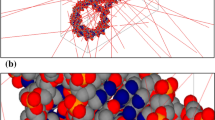Abstract
DNA models have become a powerful tool in the simulation of radiation-induced molecular damage. Here, a computer code was developed which calculates the coordinates of individual atoms in supercoiled plasmid DNA. In this prototype study, the known base-pair sequence of the pUC19 plasmid has been utilized. The model was built in a three-step process. Firstly, a Monte Carlo simulation was performed to shape a segment chain skeleton. Checks on elastic energy, distance and unknotting were applied. The temperature was considered in two different ways: (1) it was kept constant at 293 K and (2) it was gradually reduced from 350 K to less than 10 K. Secondly, a special smoothing procedure was introduced here to remove the edges from the segment chain without changing the total curve length while avoiding the production of overshooting arcs. Finally, the base pair sequence was placed along the smoothed segment chain and the positions of all the atoms were calculated. As a first result, a few examples of the supercoiled plasmid models will be presented, demonstrating the strong influence of appropriate control of the system temperature.








Similar content being viewed by others
References
Bauer WR (1978) Structure and reactions of closed duplex DNA. Annu Rev Biophys Bioeng 7:287–313
Chandrasekaran R, Arnott S (1989) The structures of DNA and RNA helices in oriented fibers. In: Landolt-Börnstein – group VII, biophysics 1B, crystallographic and structural data II. Springer, Berlin Heidelberg New York, pp 31–170
Charlton DE (1986) The range of high LET effects from 125I decays. Radiat Res 107:163–171
Charlton DE, Humm JL (1988) A method of calculating initial DNA strand breakage following the decay of incorporated 125I. Int J Radiat Biol 53:353–365
Friedland W, Jacob P, Paretzke HG, Merzagora M, Ottolenghi A (1999) Simulation of DNA fragment distributions after irradiation with photons. Radiat Environ Biophys 38:39–47
Harris BA, Harvey SC (1999) Program for analyzing knots represented by polygonal paths. J Comput Chem 20:813–818 (now that uracil.cmc.uab.edu has been shut down, the program is available at http://rumour.biology.gatech.edu/Publications/1998–2000.shtml)
Humphrey W, Dalke A, Schulten K (1996) VMD – visual molecular dynamics. J Mol Graphics 14:33–38 (http://www.ks.uiuc.edu/Research/vmd)
Jian H, Schlick T, Vologodskii A (1998) Internal motion of supercoiled DNA: Brownian dynamics simulations of site juxtaposition. J Mol Biol 284:287–296
Kassis AI, Harapanhalli RS, Adelstein SJ (1999) Comparison of strand breaks in plasmid DNA after positional changes of Auger electron-emitting Iodine-125. Radiat Res 151:167–176
Kassis AI, Walicka MA, Adelstein SJ (2000) Double-strand break yield following I-125 decay – effects of DNA conformation. Acta Oncol 39:721–726
Klenin K, Langowski J (2000) Computation of writhe in modeling of supercoiled DNA. Biopolymers 54:307–317
Nikjoo H, Uehara S (1994) Comparison of various Monte Carlo track structure codes for energetic electrons in gaseous and liquid water. In: Varma MN, Chatterjee A (eds) Computational approaches in molecular radiation biology. Plenum, New York, pp 167–185
Paretzke HG (1987) Radiation track structure theory. In: Freeman GR (ed) Kinematics of nonhomogeneous processes. Wiley, New York, pp 89–170
Petzold O (2001–2003) Tiny vector matrix library using expression templates. http://tvmet.sourceforge.net
Pomplun E (1991) A new DNA target model for track structure calculations and its first applications to I-125 Auger electrons. Int J Radiat Biol 59:625–642
Pomplun E, Terrissol M (1994) Low-energy electrons inside active DNA models: a tool to elucidate the radiation action mechanisms. Radiat Environ Biophys 33:279–292
Sahu SK, Kassis AI, Makrigiorgos GM, Baranowska-Kortylewicz J, Adelstein SJ (1995) The effects of indium-111 decay on pBR322 DNA. Radiat Res 141:193–198
Terrissol M, Pomplun E (1994) A nucleosome model for the simulation of DNA strand break experiments. In: Varma MN, Chatterjee A (eds) Computational approaches in molecular radiation biology. Plenum, New York, pp 243–250
Terrissol M, Vrigneaud JM (2001) Analogue Monte Carlo to model radiation induced DNA damage. In: Kling A, Barao F, Nagakawa M, Távora LMN, Vaz P (eds) Advanced Monte Carlo for radiation physics, particle transport simulation and applications. Springer, Berlin Heidelberg New York, pp 261–266
Tomita H, Kai M, Kusama T, Ito A (1998) Monte Carlo simulation of DNA strand-break induction in supercoiled plasmid pBR322 DNA from indirect effects. Radiat Environ Biophys 36:235–241
Vologodskii AV, Levene SD, Klenin KV, Frank-Kamenetskii M, Cozzarelli NR (1992) Conformational and thermodynamc properties of supercoiled DNA. J Mol Biol 227:1224–1243
Watanabe R, Saito K (2002) Monte Carlo simulation of strand-break induction on plasmid DNA in aqueous solution by monoenergetic electrons. Radiat Environ Biophys 41:207–215
Yanisch-Perron C, Vieira J, Messing J (1985) Improved M13 phage cloning vectors and host strains: nucleotide sequences of the M13mp18 and pUC19 vectors. Gene 33:103–119
Author information
Authors and Affiliations
Corresponding author
Rights and permissions
About this article
Cite this article
Kümmerle, E.A., Pomplun, E. A computer-generated supercoiled model of the pUC19 plasmid. Eur Biophys J 34, 13–18 (2005). https://doi.org/10.1007/s00249-004-0431-2
Received:
Revised:
Accepted:
Published:
Issue Date:
DOI: https://doi.org/10.1007/s00249-004-0431-2




